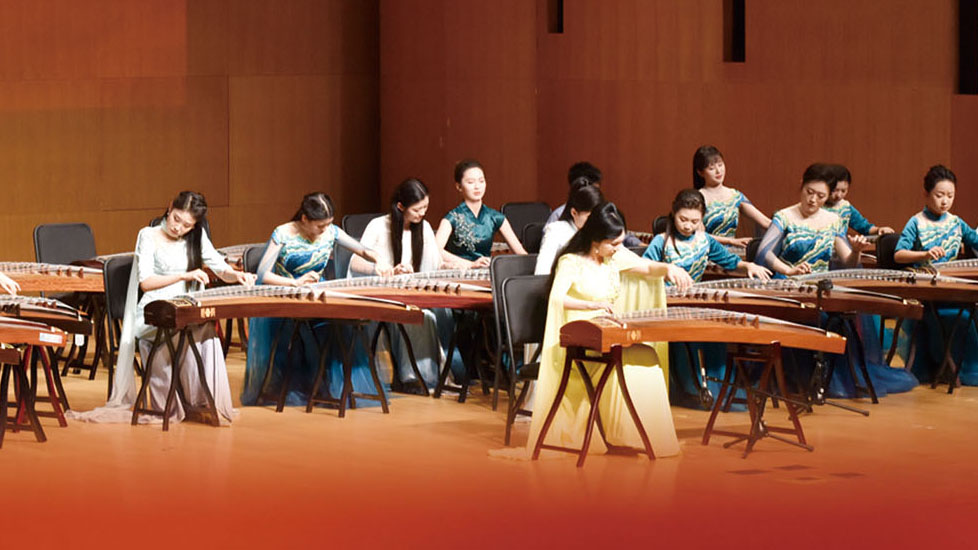Ji Wei, a renowned guzheng artist, enhances the traditional Chinese instrument's appeal and global presence through cultural outreach.

On July 21, Ji Wei, a guzheng artist and the deputy director of the Department of Traditional Chinese Music at the Central Conservatory of Music, led a performance with a group of young musicians in a guzheng ensemble concert at the National Library Arts Center in Beijing.
Ji's journey with the guzheng, a Chinese zither, began at the age of five. As she immersed herself in the instrument, she came to appreciate its cultural richness and diverse charm over the years.
"The sound of the guzheng can convey both melancholic and cheerful emotions: its lower range exudes solemn and dignified music, its middle range displays great tenderness, and its high notes can be incredibly majestic," Ji explained.
READ MORE: Hitting rare notes
For decades, Ji has been an ambassador for the guzheng on the international stage, performing at prestigious venues such as the Lincoln Center in the US, the Golden Hall of Vienna in Austria, the Sydney Opera House in Australia, and the Royal Albert Hall in the UK.
"When I first started performing overseas, many Western audiences would ask me if I was playing the koto, a Japanese plucked string instrument," Ji recalled. "It was then that I realized I had a huge responsibility to help more people learn about the guzheng, this remarkable traditional Chinese instrument."
Whenever Ji performs, she often shares a brief history of the guzheng. For instance, it was originally known simply as the zheng when it first appeared during the Warring States Period (475-221 BC), and the prefix "gu" was added later to mean "ancient" in Chinese.
She also emphasizes that music can sometimes speak louder than words.
"Every performance is like a direct conversation between the performer and the audience," she said. "When I performed overseas, the audience responded enthusiastically and showed great respect for our culture, which fostered further cultural exchange and collaboration."
For several years, Ji participated in a special workshop hosted by the Royal Conservatoire The Hague in the Netherlands. Each year, musicians from around the world would gather in the Netherlands for two months, learning about each other's music and instruments and ultimately creating new music together.
"It was an open and friendly environment for exchange, and all the participants were professionals in the music industry. For the public, however, it takes longer to learn about and understand our music and culture," said Ji.
Ji acknowledged that promoting the guzheng both domestically and internationally requires more than her individual efforts. However, she observed that over the past 30 years, the number of people learning the guzheng — both professionally and recreationally — has increased significantly.
"I believe the guzheng is the most popular traditional Chinese instrument, with millions of people learning it," she said.
Ji explained that one key reason for this popularity is the guzheng's beginner-friendly nature.
"Instruments like the erhu and violin require a bow and it takes a long time to produce a decent sound. With the guzheng, you get the right pitch and a pleasing sound right away as you pluck the strings. This makes it easier for beginners to stick with it," she said.
Ji also mentioned that the guzheng's therapeutic effects might contribute to its growing appeal in today's world.
"With many people struggling with anxiety and possibly depression, music therapy has become more popular," Ji said. "Traditional music, like that of the guzheng, can have a calming effect on the mind."
Cultural confidence also plays a crucial role in this change, according to Ji.
"More people in China are embracing traditional Chinese culture because it resonates with our aesthetic values," Ji said. "The guzheng is a powerful symbol of our heritage and culture; it can be seen frequently at national events and international performances."
ALSO READ: A natural harmony
Recently, a growing number of Generation Z individuals have been promoting traditional Chinese music by playing instruments like the guzheng and pipa, either on the streets of foreign countries or on social media platforms. They often wear traditional Chinese hanfu while performing pop music pieces, both Chinese and Western.
Ji is delighted to see young people using traditional music to express themselves and blending the dynamic sound of the guzheng with pop culture.
"After all, it's unrealistic for Gen Zers to instantly fall in love with music from a thousand years ago," she said. "This kind of creative promotion offers a fresh approach to popularizing traditional instruments and bridges the gap between history and youth."
However, Ji noted that this is just the beginning. "As more people become familiar with the guzheng and develop an interest, it's important for them to also understand the cultural heritage behind it in order to truly appreciate and preserve it."


